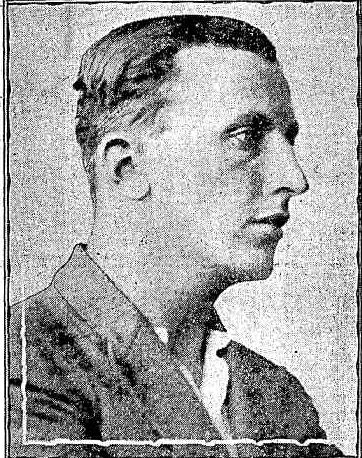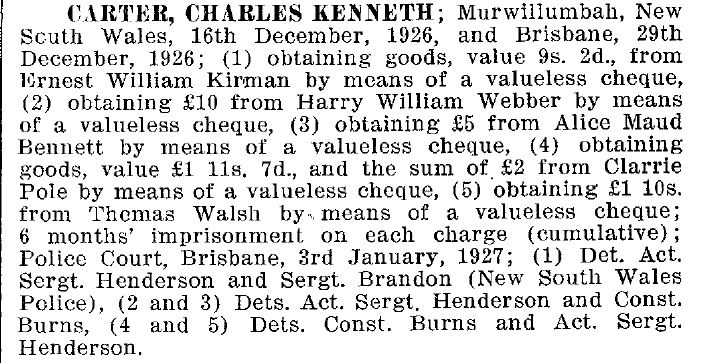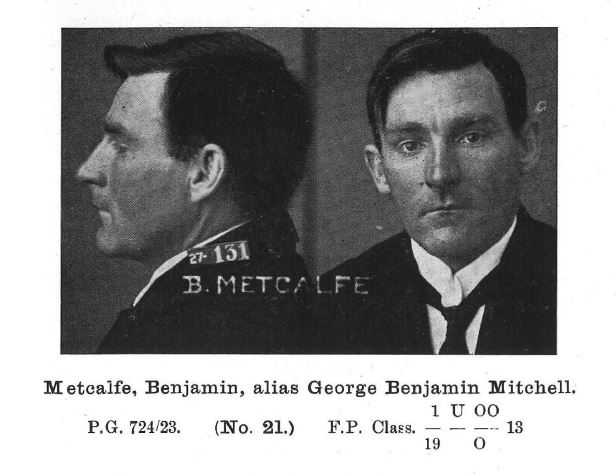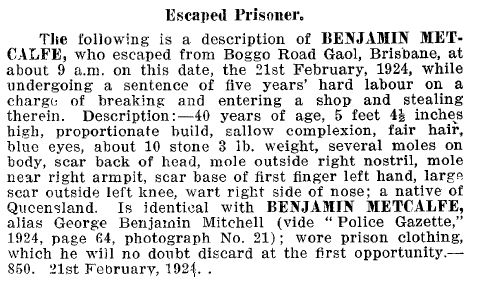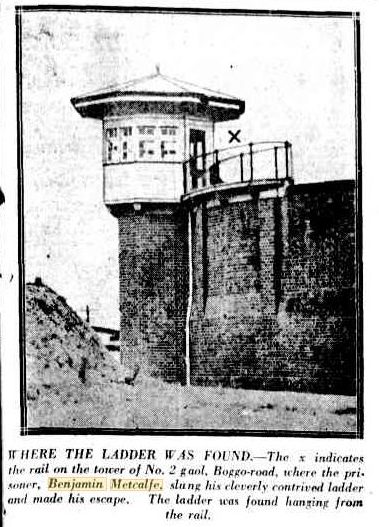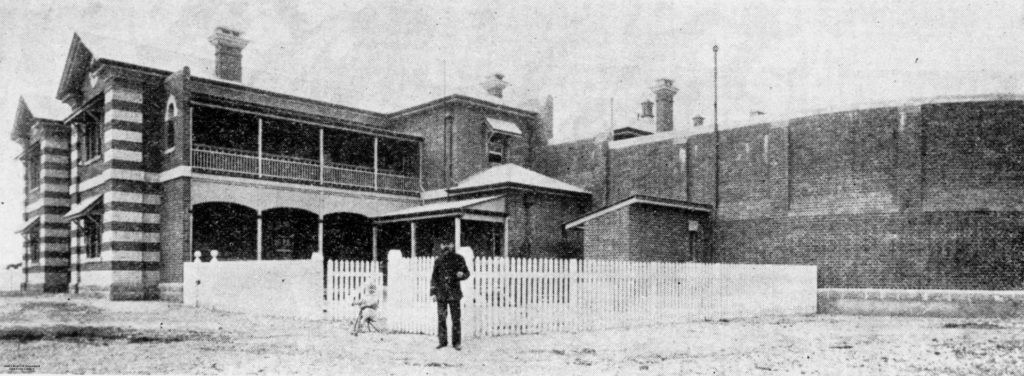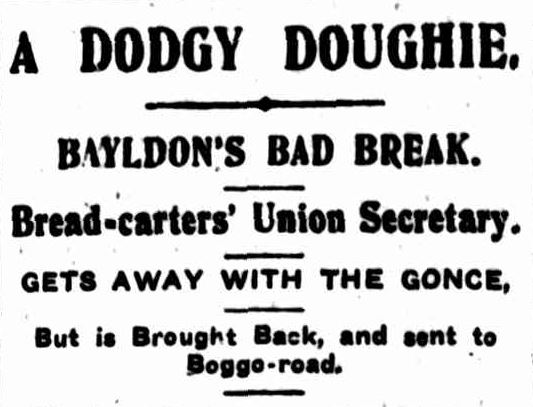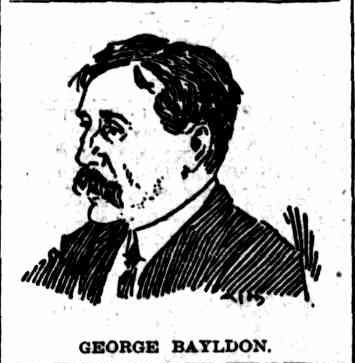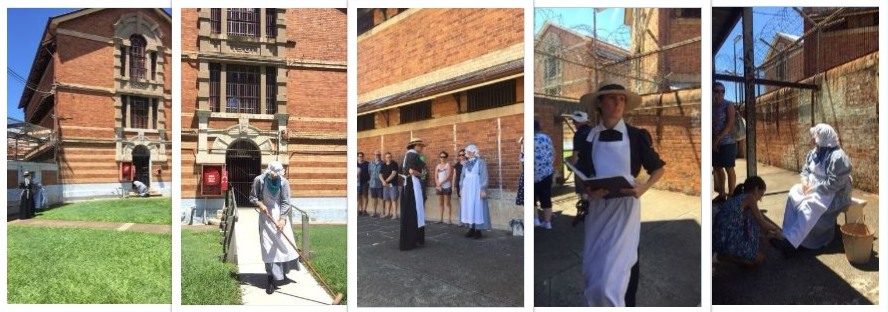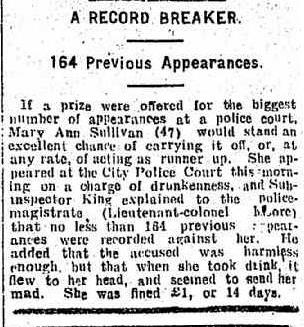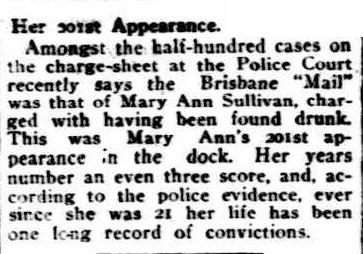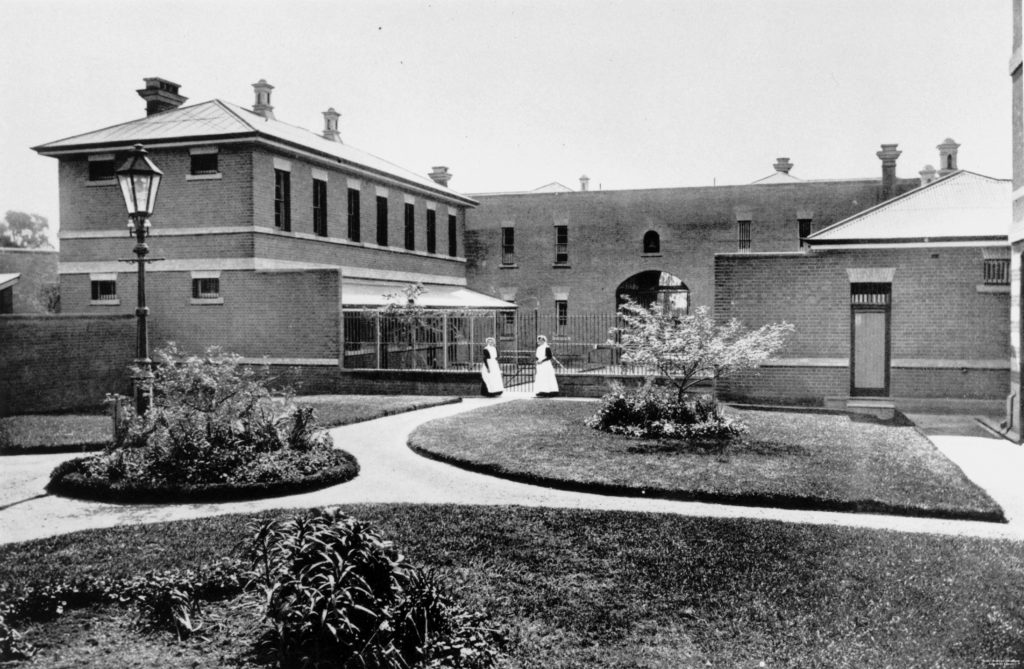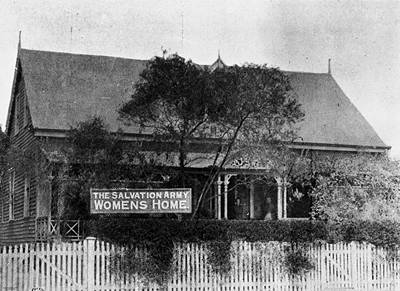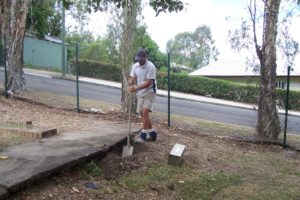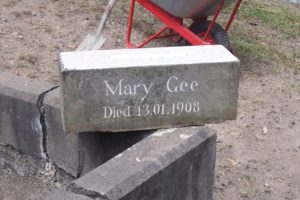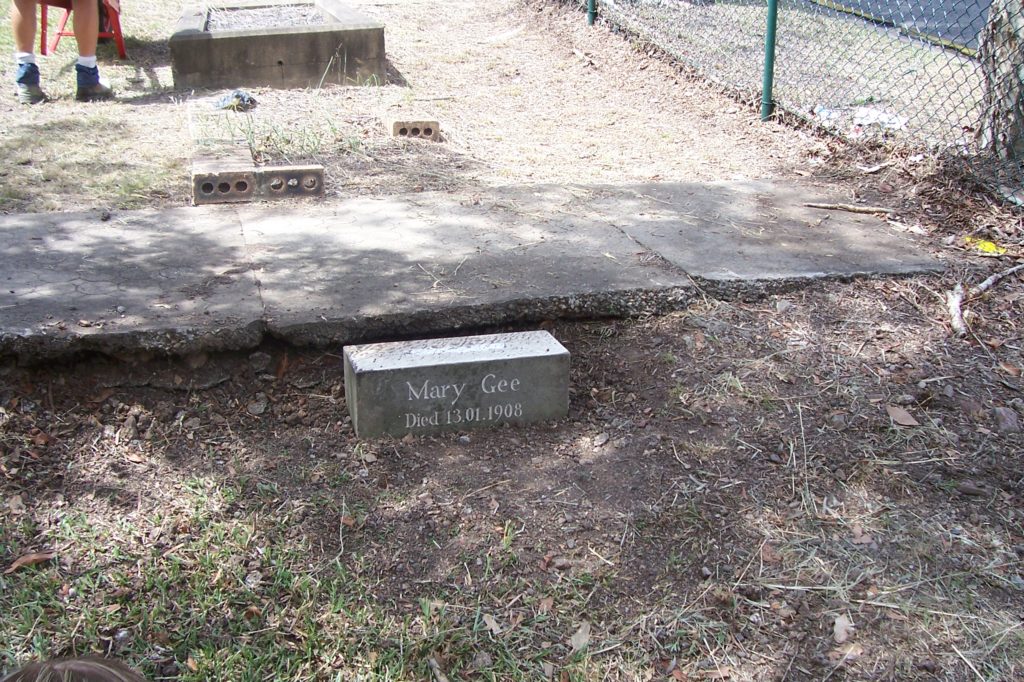Officer Stories 3 – Major Arthur Thomas Peirson VD
- On : 19 April, 2018
- By : Boggo Road Gaol
- Category : Stories
- View : 2059
Officer Stories 3 – Major Arthur Thomas Peirson VD
Superintendent for Prisons Brisbane and Chief Controller for Prisons
Peirson served forty-eight years in the prison department, a truly remarkable career. Peirson was a penologist with great humanitarian principles. He was a stern but just disciplinarian in his management of the prisons in Queensland.
Major Arthur Thomas Peirson VD
Superintendent for Prisons Brisbane and Chief Controller for Prisons
Arthur Thomas Peirson was born on the 5th of October 1867 in Newcastle upon Tyne, England to Joseph and Margaret Peirson. A military family, the Peirson’s travelled around Europe before Arthur and his brothers were educated in Scotland.
A military cadet, Peirson served his cadetship under his Uncles tutelage. Upon completion and with the help of his father, Arthur Thomas Peirson obtained a position as clerk for Chief Controller for Prisons A.E. Halloran. Peirson travelled to Queensland in 1885 as a teenager to join the ranks in the prison service.
Military Career
Peirson not content with just completing his cadetship, joined the Queensland Military Forces (QMF) in the 1st Moreton regiment where he served in the Boer War campaign and saw action in the shearers strike in Bundaberg, all while maintaining his position in the prisons department and slowly rising through the ranks.
Peirson remained in the QMF until his retirement at the rank of Major in 1920. He was awarded the Victorian Decoration for long and distinguished service to the QMF.
Prison Career
Peirson was appointed Acting Superintendent for HM Prisons Brisbane in June of 1904 after the death of Superintendent J.V. Williams, a position that Peirson would go on to hold for the remainder of his life.
A prisoner advocate, Peirson achieved great popularity with the officers and prisoners alike. He developed a series of prison reforms that were a very warranted change from the old system of only punishment. Peirson introduced a system of teaching useful trades to the long serving prisoners in the hope that when they were eventually released from prison they will manage to be a functional member of society. In order to achieve this, Peirson himself became proficient at the trades being taught to the prisoners so as best to supervise them. Trades such as brush-making, shirt-making and mat-making were introduced.
Other significant changes were made in the time of Peirson, including the extension of library and educational services for long serving inmates, better food and conditions, more frequent welfare checks and much tighter reigns on the prison staff.
Peirson served forty-eight years in the prison department, a truly remarkable career. Peirson was a penologist with great humanitarian principles; a stern but just disciplinarian in his management of the prisons in Queensland.
Death in Office
Peirson died at his home, at HM Prison Brisbane (later known as Boggo Road Gaol) on the 16th of May 1933 having been suffering from a stubborn illness for some time. He was survived by his devoted wife and only son who also worked in the prison service.
The day Peirson died, an impressive tribute to the memory of their late Chief was paid by the warders of the day shift. As each man finished duty at 5 o’clock, he marched towards the Superintendent’s official residence, halted a few paces from the entrance, stood erect and saluted, before marching, after a moment’s pause, out of the gates. It was a simple, dignified, and spontaneous tribute that bore eloquent testimony to the respect and esteem in which the late Superintendent was held by the prison staff.
The funeral procession was equally as impressive. A guard of honour led by Senior Warder Dwyer was drawn up outside of the Superintendent’s residence. Lt. Governor Sir James Blair and Registrar of the Supreme Court Mr. F. S. Kennedy entered the residence where a small service was held. The cortege then made its way to the South Brisbane Cemetery where Major Peirson was laid to rest. His grave is adorned with a lovely monument.
Sadly, we can’t hear from Major Peirson about his time as Superintendent. You can, however, hear from another officer this Sunday on our officer tour! Be guided through Boggo Road Gaol by former officer Kevin Hayden; hear from him all about some of the most terrifying riots, thrilling escapes and infamous prisoners! Click here to book.
This article was contributed by Research Coordinator Sue Olsen as part of the ongoing research program for Boggo Road Gaol Pty Ltd. The aim of the program is to bring to light and share articles relating to Boggo Road for the purposes of review and study. Do you have a story to share or something you would like us to know about? You can contact the research team here
Prisoner Stories 3 – Charles Kenneth Apjohn Carter
- On : 13 April, 2018
- By : Boggo Road Gaol
- Category : Stories
- View : 1971
Charles Kenneth Apjohn Carter
International fraudster, swindler and thief.
Ever heard the saying ‘a champagne taste on a beer budget’? It is a saying that I have certainly grown up with. Charles Kenneth Apjohn Carter is simply synonymous for making the very, very best of a bad situation. At one time he broke bread with the best of Brisbane, now he is enjoying hominy with the worst of Boggo Road Gaol.
 Charles Kenneth Apjohn Carter
Charles Kenneth Apjohn Carter
Known alias: Charles Kenneth Carter, Charles Kenneth, Charles Kennett and Nick Carter.
Native Place: India
Age: 37 Years
Height: 5 feet 10 ½ inches
Make: Proportionate
Complexion: Fresh
Hair: Brown
Eyes: Hazel
Weight : 11stone 6 oz
Remarks: Appendicitis Scar, Long scar and mole on right temple, shrapnel scar above left kneecap.
Ever heard the saying ‘a champagne taste on a beer budget’? It is a saying that I have certainly grown up with. Charles Kenneth Apjohn Carter is simply synonymous for making the very, very best of a bad situation. He had falsely stated his worth for all to see…. Meanwhile pinching everything he can get his hands on!
Perhaps the most remarkable case of “False Pretences” to have ever graced the halls of Boggo Road Gaol; Charles Kenneth Apjohn Carter had swindled people out of their hard earned money over three states in Australia in the previous months. He had at each turn, escaped justice. His run of luck finally ran out when he was arrested at Murwillumbah and brought back to face five charges of passing a dodgy cheque and theft in the Police Magistrates Court in Brisbane in 1927. Found guilty, Carter was sentenced to two and half years inside Boggo Road Gaol.
He was a most gifted crook, having been born in India to a British family; he had spent most of his young life in England. In turn, he had gained himself the knowledge to pass himself off as a right proper gentleman of the highest order.
The Crime
Passing himself off as an Air Marshall, Major, Captain and golf professional at various points, he had hob knobbed around Brisbane, Warwick, Sunshine Coast and Southport with the finer classes of society. Carter dressed himself in the finest uniform of a Royal Air Force Officer complete with distinguished war medals. Arriving in Brisbane, He had recruited a woman of disrepute to take his arm and pull of this charade as “Major” and Mrs. Carter “honeymooning” in Brisbane promising her wealth. Of course, this was all just part of the swindle! When it came time to face the court, the mysterious Mrs. Carter had been ripped off too! Carter had passed her a dodgy cheque, just like all the others. None of his self-imposed titles were at all true. The plain truth of the matter was, Carter was enlisted as a mechanic in the R.A.F in 1917, had been discharged and had re-enlisted in 1918 before deserting and turning to crime.
Prior Convictions
Charles Kenneth Apjohn Carter is known all over the world for his antics. He had been charged and sentenced for fraud in the London. He was charged and declared insane in Edinburgh and served four years in an Asylum, again for fraud. There were warrants for his arrest in Canada, where he had passed himself off as a decorated pilot, even planning himself an elaborate banquet in Winnipeg, but obviously, the banquet never went ahead as he had yet again disappeared. He then allegedly went to California where had smuggled Chinese migrants into America via Mexico. All of this prior was to his assault on the good people in Australia.
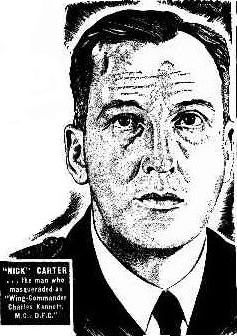
Certainly his story is one of pure fantasy, He had an inflated sense of self… and if everything else wasn’t enough. He published his autobiography in 1936, under yet another alias Charles Kennett. The Stormy Petrel is sadly out of print. However a copy is held at the National Library in Canberra.
Do yourself a favour, check out the remarkable story of Charles Kenneth Apjohn Carter further. It has certainly been one of the most fascinating and at times hilarious stories I have had the privilege to share.
This Sunday, you can hear more stories from a prisoner’s perspective. Larry Campbell, a former prisoner at Boggo Road, will guide you through some of the most turbulent years of the Gaol’s history. To book tickets for our fascinating prisoner tour click here.
This article was contributed by Research Coordinator Sue Olsen as part of the ongoing research program for Boggo Road Gaol Pty Ltd. The aim of the program is to bring to light and share articles relating to Boggo Road for the purposes of review and study. Do you have a story to share or something you would like us to know about? You can contact the research team here.
Escape! Benjamin Metcalfe
- On : 5 April, 2018
- By : Boggo Road Gaol
- Category : Stories
- View : 1921
ESCAPE! Benjamin Metcalfe
Just before 9am on Thursday 21st February 1924, Benjamin Metcalfe was at his usual work in the bookmaker’s shop when he decided it was time to escape from gaol.
ESCAPE! Benjamin Metcalfe
Benjamin Metcalfe
Alias: George Benjamin Mitchell
Crime: Stealing, Break and Enter, Burglary.
Sentence: 7 Years with hard labour
Escaped: Thursday 21st February 1924
From: HM Prison for men Brisbane (later known as No 2 Division Boggo Road Gaol)
Escape!
Just before 9am on Thursday 21st February 1924, Benjamin Metcalfe was at his usual work in the bookmaker’s shop when he decided it was time to escape from gaol. He approached the officer on duty and asked permission to leave his work to attend the sick ward at the hospital. For some reason, this was granted, and he was allowed unescorted to leave the shop. He scaled a fence at the back of the kitchen and gathered his fashioned rope ladder and threw it over the wall. Hooking it on the rail of the tower he quickly scaled the wall and disappeared. Sightings over the coming hours had him heading in the direction of Beaudesert.
No one missed Metcalfe until around 1pm when it became panic stations. Every officer was engaged in looking for him. The escape was reported to the police, but was kept from the public until the following day.
He wasn’t free for long however, as Metcalfe was recaptured just two days later at Logan Village.
The ladder
Thirty feet in length, the rope was made of 24 strands of shoemaker’s cotton twine which was twisted and coated with bees wax. This made a light cord with great strength.
The rungs were of pine, neatly rounded to half inch thickness, about six inches in length. Apparently these were made out of the ends of kerosene cases.
The cord was carefully wound round each several times and further secured by a nail.
For the grappling hook, the handle of a cell bucket had been commandeered and was weighted with a cobblers hammer.
Metcalfe worked in the bookmaker’s shop and had ready access to the requirements of the ladder; however, it still would have taken months to squirrel away the pieces of his incredible creation.
But how did he construct it and keep it hidden from the authorities? That was the subject of a board of enquiry. Five officers were suspended until the enquiry, two found guilty of negligence and carelessness in discharge of their duty.
The tower which was unattended too had been a source of controversy. Ultimately the Home Secretary Shopford accepted the blame for the tower being unattended. Still, he had numerous questions on how an escape of this kind could happen in broad day light. The tower, at the end of the day, was unguarded due to budget cuts.
Bad from Boyhood
Metcalfe was certainly no angel, he had been in trouble from a young age, skipping school and running away from home at twelve. This was just the beginning of a lifelong career afoul of the law. At twelve and a half Metcalfe was sentenced to five years in Westbrook Industrial home for stealing a purse. Eventually he saw his first year in prison in 1908 this time for Burglary.
With the exception of his two years away in the army during World War One (even during that he misbehaved) he didn’t spend much longer than a month or two at a time out of gaol.
Somehow, he managed to meet and find a girl to marry and have two children. When he wasn’t in gaol, it seemed he was with either his family or staying with his mother.
His last known sentence at Boggo Road Gaol was for selling sly grog during World War Two. He was living with his mother at Albion at the time. The sentence was short (for him) just six weeks.
His mother died in 1950, after the funeral, he travelled south to Scone, New South Wales to visit family. Metcalfe died there just a few months later.
Want to see where Metcalfe went over the wall? You can! Join us for our Escapes tour this Sunday!
Hosted by Director Jack Sim, you will hear of some of the greatest escape stories from the history of Boggo Road Gaol. To book click here
This article was contributed by Research Coordinator Sue Olsen as part of the ongoing research program for Boggo Road Gaol Pty Ltd. The aim of the program is to bring to light and share articles relating to Boggo Road for the purposes of review and study. Do you have a story to share or something you would like us to know about? You can contact the research team here
Boggo Road Gaol -The Black Maria
- On : 29 March, 2018
- By : Boggo Road Gaol
- Category : Stories
- View : 2300
Go directly to Gaol – The Black Maria
Black Maria the dreaded vehicle of the crook, hated almost as much as her more sombre sister the hearse. She slinks through the streets of Brisbane holding within some of the secrets of the underworld, the grievances of the charged and the sorrows of the sentenced.
Black Maria
The Black Maria, otherwise known as a paddy wagon or prison van; is just as it sounds- a vehicle for the transportation of prisoners. Boggo Road Gaol was just one of the frequent stops for the Black Maria of Brisbane.
Why Black Maria?
The name Black Maria is somewhat shrouded in mystery. Some say it has a literal meaning from the Hebrew name Mary (or Maria) which means bitterness. It is said that by choosing the ways of crime, the accused, riding in disgrace through the streets courtesy of the Black Maria, was surely most bitter about his situation. The wagon was painted black hence the colour reference. Others in history say it is named after Maria Lee; a large, powerful, African-American lady that ran a boarding house for drunken sailors in Boston, Massachusetts. The latter is an interesting story that is published in numerous newspapers of the late 19th Century. Its accuracy is unknown, but the story is simply too good not to share. We leave the reader to further ponder the origins of the name.
The Black Maria in Brisbane
Various versions of the Black Maria were seen in the city streets over the decades. All now are replaced by modern prison vans which are usually white in colour and are mostly unmarked. These modern vehicles can occasionally still be seen around Boggo Road Gaol; though not for the transportation of prisoners to her cells… but the officers enjoying a hot cup of coffee while waiting for their prisoners to be released either from a hospital visit or other appointment.
The modern vehicles leave behind them the legacy of the Black Maria. Now the work is separated into two parts – the van used for the transportation of prisoner’s already in prison and the Paddy Wagon used by police to transport those arrested on the city streets.
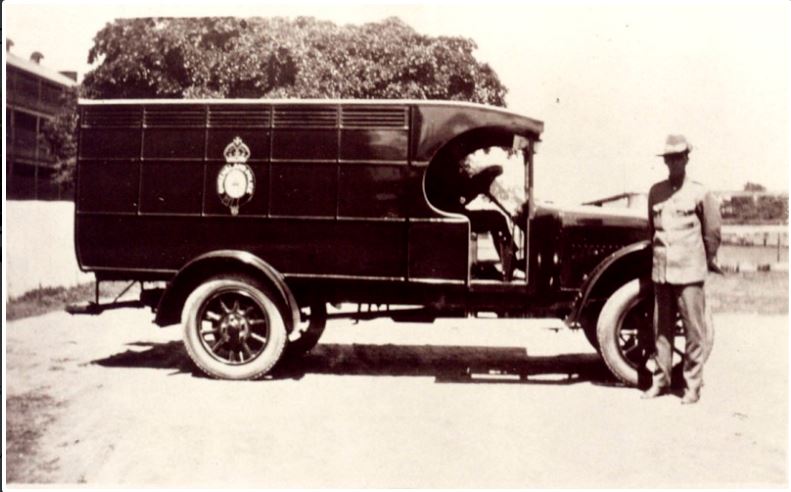
In 1925 the back of a horse drawn Black Maria was mounted to a Bean truck Chassis and created the first motorised Black Maria.
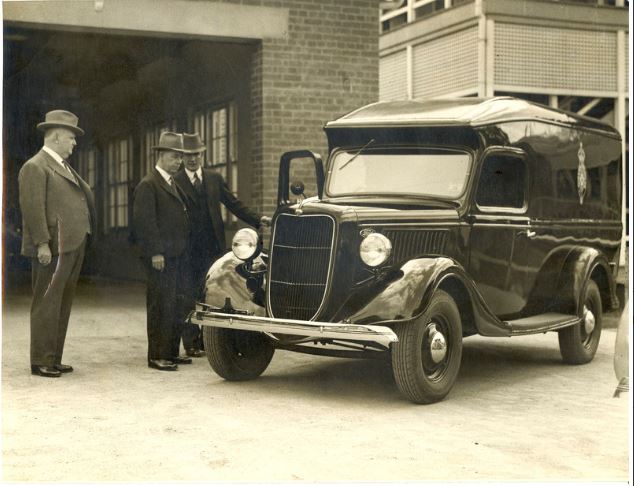
In 1936 One of these motorised Black Marias were mounted to a truck and the other was traded into the latest of limousine type vehicles.
So what of the secrets of the dreaded Black Maria?
Perhaps a few lines from the Truth newspaper on Sunday 27th of December 1931 will tell all.
What stories could she tell? If only she could speak and tell of what she knows of the men and women criminals who have been for a time encased within those closed, but silent, walls?
Black Maria the dreaded vehicle of the crook, hated almost as much as her more sombre sister the hearse. She slinks through the streets of Brisbane holding within some of the secrets of the underworld, the grievances of the charged and the sorrows of the sentenced.
No one knows the stories which are locked in the van when the key turns, no one can overhear them; they remain there removed from the ears of eavesdroppers…secrets.
Want to visit Boggo Road Gaol? Not so keen on a trip in the Black Maria? That’s okay! Other modes of transport are available to you now.
For more information on location and transport visit here
Come in and see us today! Our tours run seven days! You can book here
This article was contributed by Research Coordinator Sue Olsen as part of the ongoing research program for Boggo Road Gaol Pty Ltd. The aim of the program is to bring to light and share articles relating to Boggo Road for the purposes of review and study. Do you have a story to share or something you would like us to know about? You can contact the research team here
Officers Stories 2 – David Douglas McKee
- On : 22 March, 2018
- By : Boggo Road Gaol
- Category : Stories
- View : 1725
David Douglas McKee
First Senior Warder HM Prison (Females) Brisbane
Appointed: 10th November 1885
Age : 24
Born: Ireland
Religion: Presbyterian
Status: Married
Previous Employment : Grocer
Notations:
Transferred Toowoomba to Brisbane 08/10/1903
Previously – St Helena 01/05/1892
David Douglas McKee was born in County Armagh, Ireland to Thomas and Susannah McKee. He immigrated to Australia with his family and sought a job with the prison service having previously been a grocer.
Appointed on the 10th of November 1885 his official record is lacking in a great deal of detail. Notations made indicate that he was a Warder at St Helena Island, appointed there in 1892.
McKee was transferred to Toowoomba Prison 1895. There are several newspaper articles relating to his time there; with the most notable article detailing the moment he was promoted as Acting Chief Warder after the retirement of Chief Blaney in 1901. It seems Chief Henry Blaney was never fully replaced.
Toowoomba Gaol officially closed its doors in October of 1903. Chief Warder David Douglas McKee and his family were transferred to Brisbane in order for McKee to take up the position of Senior Warder, Clerk and Storekeeper at the new HM Prison (Females) Brisbane (later known as 2 Division Boggo Road Gaol). He arrived with 19 prisoners in his charge; he officially commenced duty at HM Prison (Females) Brisbane on the 8th of October 1903.
The journey to Brisbane via rail was a smooth one; the ladies behaved well and no incidents on the journey have been recorded. The transfer of belongings from Toowoomba to Brisbane was not so smooth. All of the possessions of the prisoners and staff of the Toowoomba prison were lost on the Toowoomba range when the truck carrying them overturned.
When he arrived, it seemed McKee’s new quarters at HM Prison were a vast improvement on the Toowoomba residences and would have proved to buoy his spirits.
McKee served in many roles in the prison service rising to Acting Superintendent of the HM Prisons (male and female) Brisbane and eventually Superintendent of the Thursday Island Prison.
He officially retired from his post as Chief Warder of the HM Prison Brisbane after over forty years in the service. He retired to his home at Hawthorne Road, Hawthorne, where he resided until his death in 1945.
David Douglas McKee is buried in the Balmoral Cemetery with his wife; he left behind a substantial war-time estate to his surviving children.
Unfortunately, There is no surviving image of David Douglas McKee. It is thought that the officer in the photograph above could possibly be him. The evidence being – he would have taken up residence in these quarters and he had a small child (as can be seen in the photograph on a tricycle) at the time. It is also more likely that the Senior Warder would have posed for this photograph being the Senior Officer. In any case, it gives an accurate representation of the officers of the time.
This photograph is one of a series printed in the Queenslander Newspaper on the 28th of November 1903 relating to the opening of the new female prison.
Do you know more about David Douglas McKee? We would love to hear it! You can contact the research team here
Sadly, we can’t hear about the Gaol from David McKee’s point of view. You can, however, hear from another officer this Sunday on our officer tour! Be guided through Boggo Road Gaol by former officer Kevin Hayden; hear from him all about some of the most terrifying riots, thrilling escapes and infamous prisoners! Click here to book.
This article was contributed by Research Coordinator Sue Olsen as part of the ongoing research program for Boggo Road Gaol Pty Ltd. The aim of the program is to bring to light and share articles relating to Boggo Road for the purposes of review and study. Do you have a story to share or something you would like us to know about? You can contact the research team here
From the Headlines – A Dodgy Doughie
- On : 15 March, 2018
- By : Boggo Road Gaol
- Category : Stories
- View : 1458
From the Headlines – A Dodgy Doughie
The remarkable story of a dodgy doughie that went to great lengths to cover up his crime!
Name: George Henry Bayldon
Company: Bread Carters Union
Position: Secretary
Crime: Theft – money belonging to the Union.
Total: £5/5/0
George Henry Bayldon was certainly not one of the worst of the worst to spend time locked up in HM Prison – Brisbane, later called Boggo Road Gaol. He did, however, commit a crime, was sentenced and did his time.
So what did he do? He spent the money belonging to the Bread Carters Union to keep his family. The wages for these workers was not even close to being enough to get by. He thought that he would be able to borrow the money and return it before the next meeting, but due to his financial state, the loan was refused.
Instead of owning up to the theft, and asking for time to re-pay citing the circumstances he was in, George took the astounding step of faking an assault and robbery on himself. He threw himself on the footpath knocking him almost cold; ensuring to scrape both sides of his face. He scattered his papers and possessions all over the road, lay still, and waited for someone to happen by before yelling for help.
Of course, the Good Samaritan took care of him and transported him home. But the rouse wasn’t over yet! He went to the trouble of summoning the police, and made a full report. It wasn’t until Tom Power, a noted officer of the law, (who happened to have been passing by that very spot at the time of the supposed incident) disputed his report and George Henry Bayldon finally confessed to the theft and the subsequent rouse.
For some unknown reason, he was not arrested on the spot and the Union was left to deal with the matter. Amazingly, they didn’t act on it speedily at all! Perhaps there was some sympathy for Bayldon? Regardless, Bayldon didn’t hang around to find out. He fled up north, obtaining employment on the Johnstone River Tramway outside of Ingham. It was September before a warrant was issued for his arrest.
Finally, George Henry Bayldon faced his day in court. He appeared before Police Magistrate Macfarlane. Even though he threw himself on the mercy of the court saying “I had no intention of keeping the money! I only took it to keep my wife from want” it fell on deaf ears.
The magistrate sentenced him to four months with hard labour in Boggo Road Gaol, additionally, the money found in his possession at the time of his arrest was to be handed to the Union. Furthermore, the magistrate remarked that should Bayldon be able to raise the remainder of the stolen money within four weeks, his sentence would be reduced to one month with hard labour. Therefore, some sympathy was felt for his family’s plight.
Bayldon however, could not raise the money in time and he served his full sentence with hard labour. He did, however, get his daily bread in gaol!
After his release, Bayldon and his family left Queensland and headed south. He died in Fairfield, Sydney in 1935.
So ends the story of the dodgy doughie of Boggo Road Gaol.
This Sunday, you can hear more stories from a prisoner’s perspective. Larry Campbell, a former prisoner at Boggo Road, will guide you through some of the most turbulent years of the Gaol’s history. To book tickets for our fascinating prisoner tour click here.
This article was contributed by Research Coordinator Sue Olsen as part of the ongoing research program for Boggo Road Gaol Pty Ltd. The aim of the program is to bring to light and share articles relating to Boggo Road for the purposes of review and study. Do you have a story to share or something you would like us to know about? You can contact the research team here.
Boggo Road Gaol – A Female Perspective – Thank You
- On : 10 March, 2018
- By : Boggo Road Gaol
- Category : Stories
- View : 1880
Boggo Road Gaol – A Female Perspective – Thank You!
Queensland Women’s Week and International Women’s Day – Over the past week we have been posting articles relating to the history of HM Prison (females) Brisbane (later known as Number 2 Division Boggo Road Gaol) and the women that made it their home. This was to coincide with two events being held in Queensland, firstly the launch of Queensland Women’s Week and secondly to celebrate International Women’s Day.
Over the past week we have been posting articles relating to the history of HM Prison (females) Brisbane (later known as Number 2 Division Boggo Road Gaol) and the women that made it their home. This was to coincide with two events being held in Queensland, firstly the launch of Queensland Women’s Week and secondly to celebrate International Women’s Day.
During this week we held two very special events at the Gaol, on Sunday the 4th of March and Thursday the 8th of March. At these events we held a complimentary morning tea served with scones and tea followed by special guided History Tour at 11:00am lead by a female guide. The tour took visitors back to the early 1900’s to look at Boggo Road Gaol, from an all-female perspective.
The highlight of the tour was the Prison Players Theatre Troupe bringing “Boggo” to “life” with entertaining and dramatic re-enactments for these very special events. Visitors to the Gaol were lined up as part of the inspection queue by the Matron, made to help with the chores and even played a game of hopscotch.
A thoroughly wonderful time was had by all! Many visitors came forward to tell their own stories of Boggo Road Gaol. Do you have a story you would like to share? We would be delighted to hear from you!
Tour Photographs
Thank you!
On behalf of management and staff at Boggo Road Gaol a sincere thank you to everyone that supported Queensland Women’s Week and International Women’s Day at Boggo Road Gaol! We hope you have enjoyed celebrating through our immersive history tours and written stories about some of Boggo Road Gaol’s most infamous female personalities.
This article was contributed by Research Coordinator Sue Olsen as part of the ongoing research program for Boggo Road Gaol Pty Ltd. The aim of the program is to bring to light and share articles relating to Boggo Road for the purposes of review and study. Do you have a story to share or something you would like us to know about? You can contact the research team here
Boggo Road Gaol – A Female Perspective – Mary Ann Sullivan
- On : 9 March, 2018
- By : Boggo Road Gaol
- Category : Stories
- View : 1637
A Female Perspective – Mary Ann Sullivan
Perhaps one of the most frequent visitors to HM Prison (Females) Brisbane (later known as 2 Division Boggo Road Gaol) In fact, she easily accounts for one of the largest number of convictions ever seen in Queensland history.
Mary Ann Sullivan
Native of: Ireland
Aged: 59
Height: 5 feet 2 inches
Weight: 8 stone 2 ounces
Build: Medium
Complexion: Sallow
Hair: Brown
Eyes: Blue
Markings: Tattoo cross over three strokes, a male figure, “Brisbane Charlie Rund, 1877” right arm; Tattooed left shoulder, “Jack Roache”; ears pierced.
Conviction: Drunkenness
(*correct at the time of her last conviction)
Perhaps one of the most frequent visitors to HM Prison (Females) Brisbane (later known as 2 Division Boggo Road Gaol) In fact, she easily accounts for one of the largest number of convictions seen in Queensland History.
Mary Ann Sullivan was an addict. She had a severe addiction to Alcohol. This meant that she would do anything that she needed to do to feed her habit.
Her first conviction was in 1876 at just 18 years of age where she was sent to the Fortitude Valley Gaol; her last that we have discovered was in 1917 her 201st conviction. The range of offences varies. But mostly for Drunkenness. It is impossible to cover her vast criminal career here. We have chosen one year 1912, to simply shine some light on this complicated woman.
For two months and twenty-eight days in 1912 Boggo Road Gaol had the presence of fifty year old Irish prisoner Mary Ann Sullivan. Mary was no stranger to the life of crime her first encounter this year with was on the 11th of January tried at North Brisbane for the offence of loitering with the sentence of one month imprisonment. With only eleven days between when she was released and when she re-entered Mary was charged with drunkenness on the 22nd of February; and served fourteen more days within the walls of Boggo Road Gaol. Her journey had not ended yet accumulating another fourteen days for the crime of loitering on the 21st of March. Sullivan’s final conviction for the year was on the 16th of April for a further one month imprisonment for the offence of drunkenness.
After her release in 1917, Mary Ann Sullivan simply disappears from the system. Do you know what happened to Mary Ann?
A sincere thank you to everyone that supported Queensland Women’s Week and International Women’s Day at Boggo Road Gaol! We hope you have enjoyed celebrating through our immersive history tours and written stories about some of Boggo Road Gaol’s most infamous female personalities.
This article was contributed by Researcher Anique Sanders as part of the ongoing research program for Boggo Road Gaol Pty Ltd. The aim of the program is to bring to light and share articles relating to Boggo Road for the purposes of review and study. Do you have a story to share or something you would like us to know about? You can contact the research team here
Boggo Road Gaol – A Female Perspective – Dora Damkohler
- On : 8 March, 2018
- By : Boggo Road Gaol
- Category : Uncategorized
- View : 1489
A Female Perspective – Dora Damkohler
“I’m a disgrace to my sex, and have been drinking Morphia and Chloral.
I’m drunk now, but I’m not a criminal, and why should I be sent to Gaol?”
Dora Damkohler 9th May 1903.
Dora Damkohler 
Alias: Dora Martin
Age: 33
Native Of : France
Height: 5 feet 3 1/2 Inches
Build: Slight
Complexion: Sallow
Hair: Brown
Eyes: Grey
15 Prior Convictions
Markings : False teeth upper jaw. White spots on face.
Dora Damkohler, a French immigrant, had a dangerous addiction to alcohol, more specifically spirits, chloral and morphia. However, because of this, she made every effort in the courtroom to change the way women were treated in gaol and to seek rehabilitation for herself and other addicts.
Dora Damkohler, also known as Martin, was known among the police at the Central Police Court in Brisbane. Her troubles first landed her in the hands of Boggo Road Gaol first in 1903, where she paid regular visits every couple of month for the next several years until her final sentencing in 1908.
With every encounter with the police, she pleaded guilty to not being a criminal, but a woman who wanted the chance to be helped through rehab. Her active espousal for the government to form an Inebriate Home (or rehab centre) to fully mend her critical drinking habit caused chaos for the Brisbane Police Court. Her case was the first of many to make the court realise that 3 months in gaol will not cure her, and others, of their dependence on alcohol; and there was a need for an establishment of a recovery program.
Damkohler, a fiery woman who had a strong desire for receiving help, won over her addiction, which lead to the establishment of rehabilitation, resulting in help for other struggling prisoners.
In celebration of Queensland Women’s Week and International Women’s Day, we are delighted to share the stories of Boggo Road Gaol from a female perspective.
This article was contributed by Researcher Abby Smith as part of the ongoing research program for Boggo Road Gaol Pty Ltd. The aim of the program is to bring to light and share articles relating to Boggo Road for the purposes of review and study. Do you have a story to share or something you would like us to know about? You can contact the research team here
Boggo Road Gaol – A Female Perspective- Mary Gee
- On : 7 March, 2018
- By : Boggo Road Gaol
- Category : Stories
- View : 1857
A Female Perspective – Mary Gee
Mary Gee was a lady very much of her time. Sadly though, Mary was afflicted with a severe addiction to alcohol. Married and with a child. It is not known exactly what drove Mary to drink.
Mary Gee
Aged 40 Years
Marital Status: Married
Crime: Drunkenness
Sentenced: 1 pound fine or one week’s imprisonment
Mary Gee was a lady very much of her time. Sadly though, Mary was afflicted with a severe addiction to alcohol. Married and with a child. It is not known exactly what drove Mary to drink.
On her admission, Mary was suffering terribly from Alcohol withdrawal. Known as delirium tremors or DT’s. Even in the court transcript she was recorded as being in a weak state.
She was admitted nonetheless just as all drunks were. She was bathed and dressed in prison uniform and taken to her cell. Just a short 48 hours later, she was dead.
She had died from the effects of withdrawal on the 13th of January 1908.
Her death was a great shock to all in the prison; Mary was a harmless girl, just under the effects of drink. It was too, the first death in HM Prison (females) Brisbane, since it opened just four years previously.
Her remains were removed from the prison by the local undertaker and her body buried in an unmarked grave the South Brisbane Cemetery the next day.
Matron Sarah Ann Nixon and the Chief of HM Prison (Men) Brisbane attended at the graveside.
The Monument to Mary Gee
Just before the centenary of her death the grave of Mary Gee was finally marked.
Managing Director of Boggo Road Gaol, Jack Sim; with his company Ghost Tours Pty Ltd had raised the funds for the monument from Heritage Fund contributions and also by personal contribution.
The Monument to Mary Gee was put into place in April of 2007.
Mary Gee is buried in portion 3 Grave number 36 in South Brisbane Cemetery
In celebration of Queensland Women’s Week and International Women’s Day, We are delighted to share the stories of Boggo Road Gaol from a female perspective.
This Thursday, a special tour is being held in honour of International Women’s Day. A morning tea will be served at 10am with a bargain ticket price of $20 per adult ticket for the 11am History Tour!
So ladies, come along and join us! Gentlemen bring along the ladies in your lives and lock them up for a couple hours! This special event is bookings essential as places are strictly limited.
BOOK HERE TO RESERVE YOUR PLACE!! YOU DO NOT WANT TO MISS THIS!!
This article was contributed by Research Coordinator Sue Olsen as part of the ongoing research program for Boggo Road Gaol Pty Ltd. The aim of the program is to bring to light and share articles relating to Boggo Road for the purposes of review and study. Do you have a story to share or something you would like us to know about? You can contact the research team here




